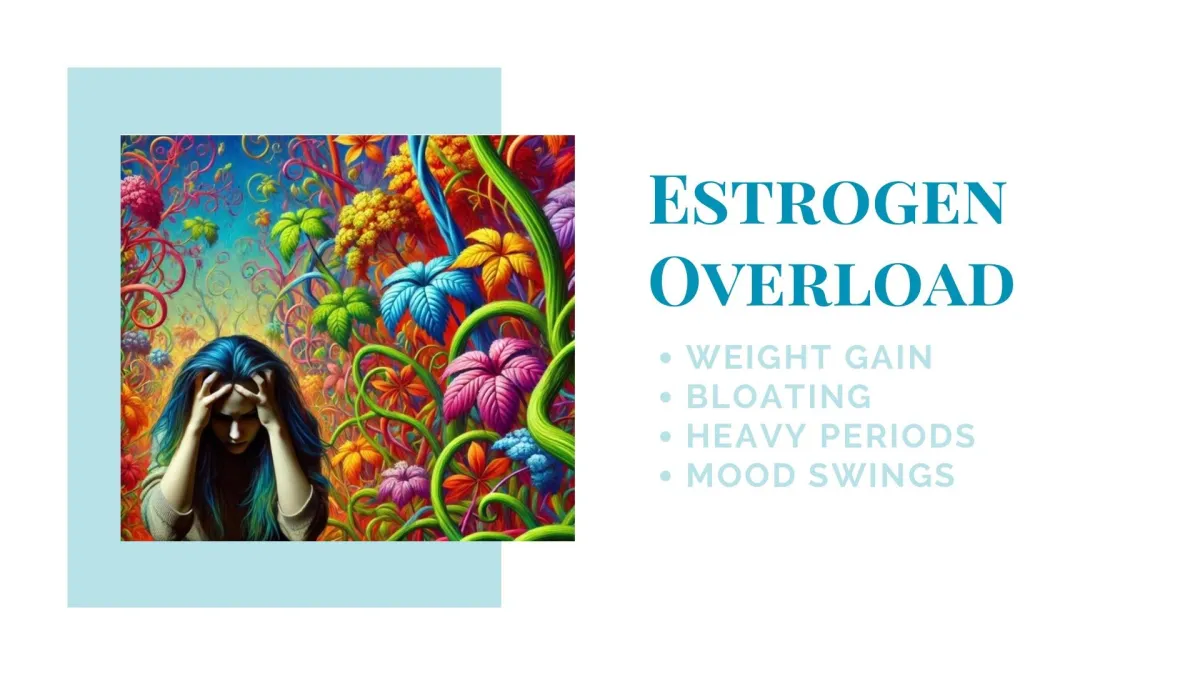
Estrogen Overload: When Your Hormones Are Out of Sync
If you landed here, it’s likely your body has been sending some loud signals: bloating, irritability, weight gain (especially around the hips and thighs), heavier or more frequent periods, sore breasts, and maybe even a sense that you’re just not quite yourself lately.
These are hallmark signs of Estrogen Overload—a state where estrogen is too high in relation to other key hormones like progesterone. And during perimenopause or early postmenopause, this type of imbalance is incredibly common—but rarely talked about with clarity.
What’s Really Going On?
As estrogen becomes more dominant and progesterone begins to decline, the balance that once kept your cycles steady and your body feeling regulated starts to shift. Estrogen itself isn’t the problem—it’s that it’s not being buffered, metabolized, or balanced the way it once was.
And when your detox pathways—especially the liver and gut—aren’t clearing estrogen efficiently, that imbalance becomes even more pronounced.
What if You’re In Perimenopause?
This type often starts to show up during early or mid-perimenopause, when progesterone levels begin to decline while estrogen remains high or erratic. You may notice heavier or longer periods, mood swings, breast tenderness, or feeling bloated before your cycle. These shifts are easy to brush off as “normal,” but they’re clear signs that your hormones are changing—and that your body is asking for support. Catching it early can make the whole transition much smoother.
But What If You’re Already Postmenopausal?
Even after your periods stop, Estrogen Overload can still show up—especially in the early postmenopausal years.
That’s because while both estrogen and progesterone drop in menopause, progesterone tends to plummet more sharply, leaving estrogen relatively unopposed. This can lead to many of the same symptoms you may have experienced in perimenopause—like breast tenderness, bloating, mood swings, and weight gain around the hips or thighs.
And here’s another layer: your body’s ability to clear and detoxify estrogen becomes even more important as you age. If your liver or gut is sluggish—or if you’re exposed to added estrogen-like compounds (through plastics, personal care products, or hormone therapy)—your estrogen levels can still build up or behave more aggressively, even if they’re technically “low” on a lab test.
Some women on hormone therapy may also experience Estrogen Overload symptoms, especially if estrogen is used without enough progesterone or without supporting detox pathways. In this case, it’s not about removing estrogen altogether—it’s about creating balance and supporting your body’s ability to process it effectively.

Symptoms You Might Be Dealing With
Bloating or puffiness that doesn’t respond to diet changes
Mood swings, irritability, or emotional ups and downs
Tender or swollen breasts
Heavy, longer, or more frequent periods (if still menstruating)
Weight gain around hips, thighs, or belly
Brain fog or feeling “off” in your own skin
Feeling like your usual tools (clean eating, workouts, supplements) just aren’t working anymore
Why This Matters
Estrogen imbalance doesn’t just make you feel uncomfortable—it can impact your thyroid function, insulin sensitivity, and even how your body stores fat. Plus, high estrogen can increase inflammation and interfere with sleep, mood, and digestion.
This is where most women get stuck: they’re doing “all the right things,” but without addressing their unique hormonal patterns, nothing seems to stick. That’s where a deeper, more targeted approach is needed.
What You Can Do About It
The good news? Estrogen Overload responds beautifully to small, consistent changes that support your hormone pathways and restore balance over time.
Simple lifestyle adjustments—like incorporating more fiber-rich foods, engaging in regular physical activity, and reducing exposure to certain environmental factors—can help manage estrogen levels.
But navigating these changes alone can be challenging. That’s where the Menopause Playbook program comes in. It’s a personalized roadmap designed to help you understand and manage your unique hormonal landscape. With expert guidance, tailored strategies, and a supportive community, you’ll have the tools you need to regain control and feel like yourself again.
Don’t let Estrogen Overload dictate your life. Take the first step towards balance and well-being.
Want a Clearer Path Forward?
If you’re tired of guessing and want real, lasting change, I invite you to join me inside My Menopause Playbook.
It’s a 4-month group coaching program built around your unique menopause type—like Estrogen Overload. You’ll learn how to balance your hormones through nutrition, movement, sleep, stress strategies, and (if appropriate) hormone therapy—all with structure, support, and expert guidance.
You’ll also be part of a warm, supportive group of women walking the same path—and you’ll walk away with a plan that actually works for your body.
And yes—it’s a 4-month commitment. But ask yourself: how long have you been dealing with these symptoms? And how much longer are you willing to wait for things to change?
Real transformation takes time—and when you give your body the consistency and support it needs, the results are absolutely worth it.
This is your time to feel better. To reclaim your spark. And to take control of your health in midlife and beyond.